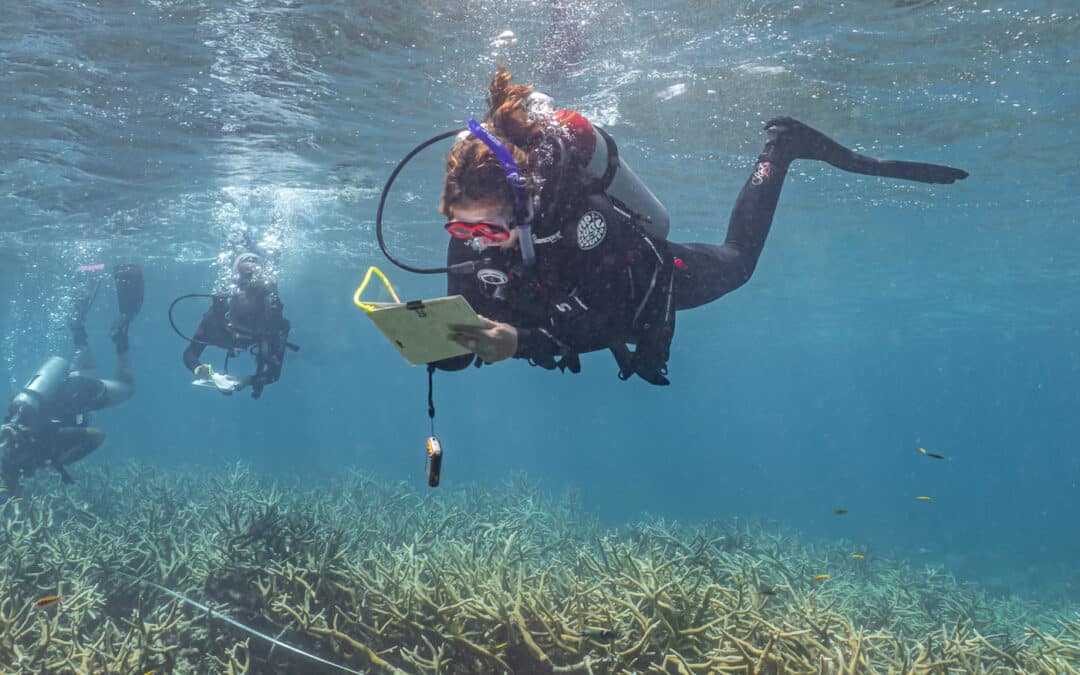Nature vs. Nurture at Coral Gardens Reef: A Rapid Response Investigation of Endangered Acropora sp. Corals in Belize
What: This project seeks enthusiastic and diverse undergraduate researchers to join our investigation of how global environmental changes are impacting the health of critically endangered corals in Belize. Project participants will contribute to vital environmental research and gain invaluable hands-on experience in a dynamic, multidisciplinary setting through application of cutting-edge techniques, including transect surveys, advanced image analysis, 3D photogrammetry, and environmental data analysis.
When: June 13-July 18, 2024 (approximate)
Where: Ambergris Caye, Belize (two weeks), Lexington, Virginia at Washington and Lee University (three weeks), GSA Annual Meeting in Anaheim, CA (September, 2024)
Who: Ten students, a peer mentor (Kylie Therrien, W&L ’25), and project directors Dr. Lisa Greer (Washington and Lee University, greerl@wlu.edu) and Dr. Karl Wirth (wirth@macalester.edu)
Prerequisites: Because this experience is a Gateway Project for rising sophomores, beyond an interest in science there are no specific coursework prerequisites. However, all students must be capable swimmers and should indicate their comfort level in water in their application materials. Prior to start of the project, all participants will complete a scuba medical questionnaire (signed by a doctor for certain pre-existing health conditions). SCUBA training in Belize requires a 200 yard swim and a 10 minute float/tread. While in the field, participants must work well with others, even as they live in close quarters, and work in the heat and sun on a boat for much of the day. Contact the Dr. Greer and Dr. Wirth if you have questions.
Expectations and Obligations:
1. Participation in all project-related work during the summer (5 weeks)
2. Submission of an abstract (individual or in groups) and presentation of a paper (poster or talk) at the Geological Society of America National Meeting in Anaheim, CA in Fall 2024 (all expenses covered).
PROJECT DESCRIPTION
Overview: Acropora cervicornis (Staghorn coral) and Acropora palmata (Elkhorn Coral) have been important reef builders throughout the Pleistocene and Holocene (Jackson, 1992; Hubbard et al., 1994: Greenstein et al., 1998). There is evidence that A. cervicornis even dominated Holocene Thermal Maximum Caribbean reefs when sea surface temperatures were similar to the 1980’s, when Caribbean Acropora species began a rapid decline in abundance (Greer et al., 2009). Yet thriving acroporid populations are now exceptionally rare in the Caribbean, with up to 98% decline suggested in the last ~50 years (e.g. Gardner et al., 2003; Precht and Aronson, 2004; Hughes et al., 2017). Causes sited for the dramatic decline of this (and other coral) species vary, but are virtually all tied directly or indirectly to human-induced environmental or climatic change (Jackson, 2001; Hughes et al., 2003; Precht and Aronson, 2004; Kuffner and Toth, 2016; Donner et al., 2017; Cramer et al., 2020).
In past years we saw an explosion of research documenting the rapid decline of corals worldwide, and dire predictions of looming collapse (Spalding and Brown, 2015; Hughes et al., 2018). But hope remains that there may be some coral refugia to withstand collapse long enough for local, regional, or global intervention and/or stabilization to occur. Coral Gardens, Belize has now been documented as a refugia (Keppel et al., 2012; Kavousi and Keppel, 2018), for endangered Acropora sp. corals (Greer et al., 2020). How long it will remain a refugia is in question (Greer et al., 2023). It is critical to understand working systems if we hope to promote persistence in coral communities, recruits for transplantation, best practices in management, and an understanding of human/environment interactions moving into a climate-stressed future (e.g. Anthony et al., 2015). This project aims to monitor the refugium status of Coral Gardens, explore the roles of nature and nurture in coral health at this site, and contribute to a growing body of research on thriving reefs (e.g. Cinner et al., 2016; Knowlton, 2017).
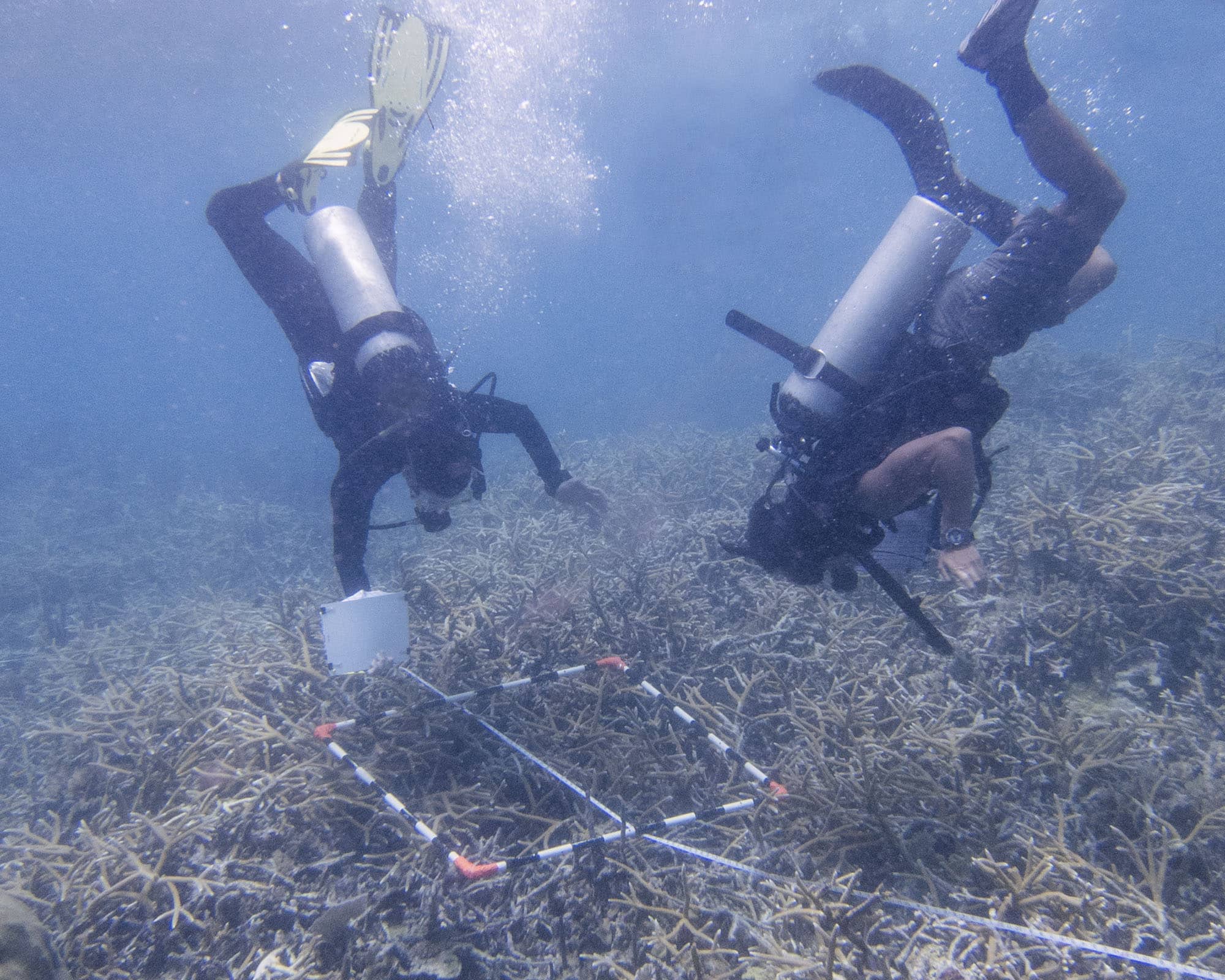
Keck Geology students studying corals along a transect.
Project Location: Ambergris Caye is an extension of the southernmost Yucatan Peninsula and is situated northeast of mainland Belize. This project will primarily take place at a site called Coral Gardens, off the southern tip of Ambergris Caye, Belize which sits between the 1,116 hectare Hol Chan Marine Reserve, created in 1987, and Caye Caulker Marine Protected Areas (Fig. 1). Coral Gardens has no protected status. The modern Belize barrier reef system began to develop as a fossil reef platform at the peak of the last interglacial, and the youngest limestones exposed on Ambergris date ~125,000 ybp (Mazzullo et al., 1992). Flooding of the platform ~6,500 ybp created extensive lagoonal patch reefs forming inland of the barrier reef crest where Acropora sp. corals have been dominant reef builders off Belize for at least much of the Holocene (Aronson et al., 2002) until the 1980’s.
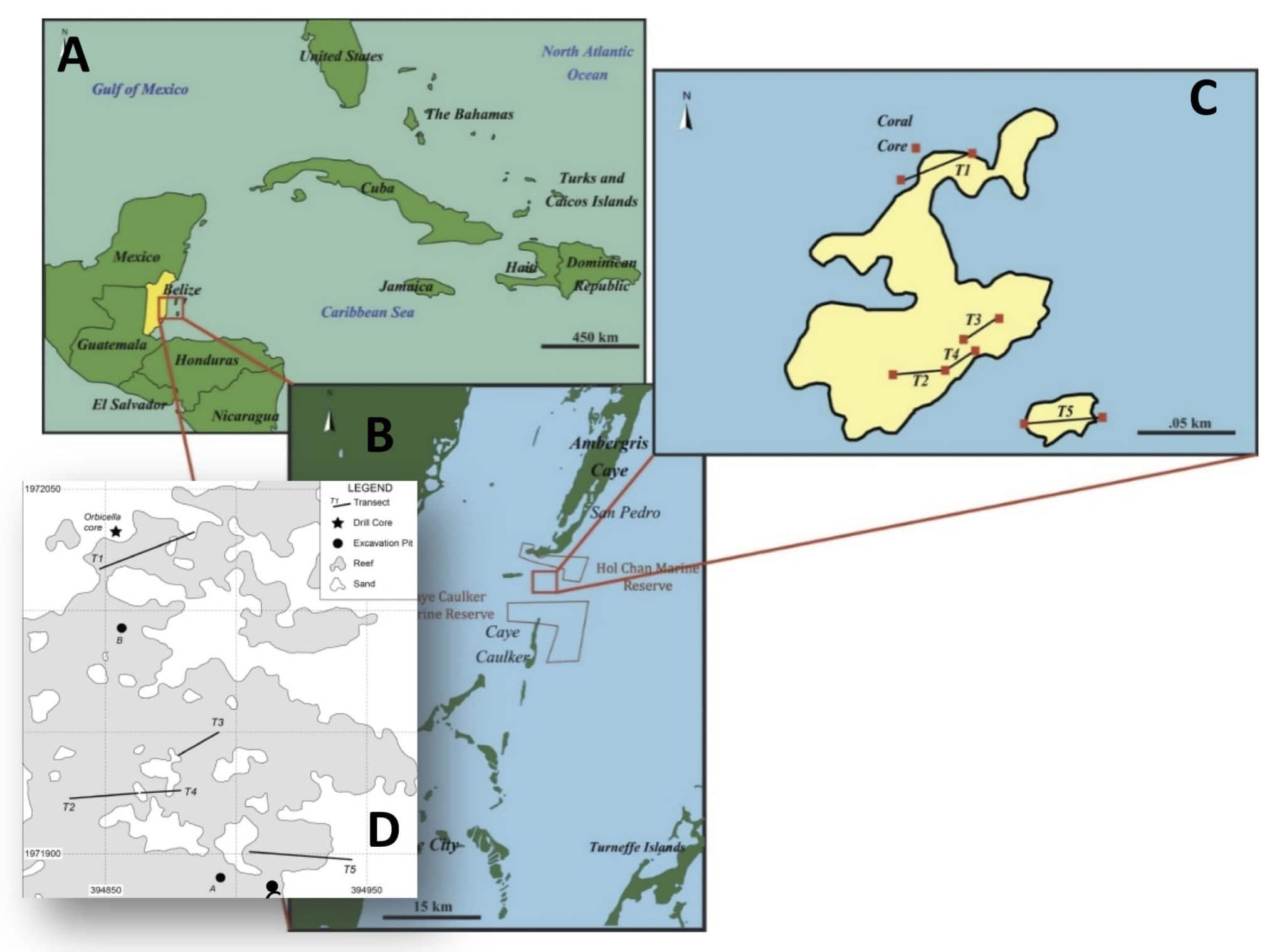
Figure 1: Map of Coral Gardens on the Mesoamerican Barrier Reef off the coast of Belize. Map A shows the relative location in the Caribbean and map B shows the location of Coral Gardens and marine reserves near the study site. Red squares at Coral Gardens (C) mark buoys and straight black lines mark coral transects within the study area. D is a detailed map of live coral produced by 2014-15 Keck students.
The center of Coral Gardens is composed of acroporid-dominated patches that are variably connected to one another. Since 2012 the Greer lab has been monitoring live coral cover at Coral Gardens along 5 established semi-permanent transects (Fig. 1). Each transect end has been marked with rebar stakes, underwater buoys, and high resolution GPS measurements (Fig. 2). Each year photographs are taken of individual quadrats placed along each transect. Images are rectified and scaled and live coral is manually segmented as overlays on each quadrat. Areal coverage is quantified using MATLAB and all living coral tips are mapped on each image (Fig. 3). Temperature, light, and conductivity have been measured at up to 15 minute intervals across Coral Gardens and additional reef locations since 2013. In some years (including during the 2014-2015 Advanced Keck project and a 2019 Gateway Keck project), many other variables have been assessed at Coral Gardens, including genetic diversity, herbivore abundance (fish and urchins), reef bathymetry, and sediment character.
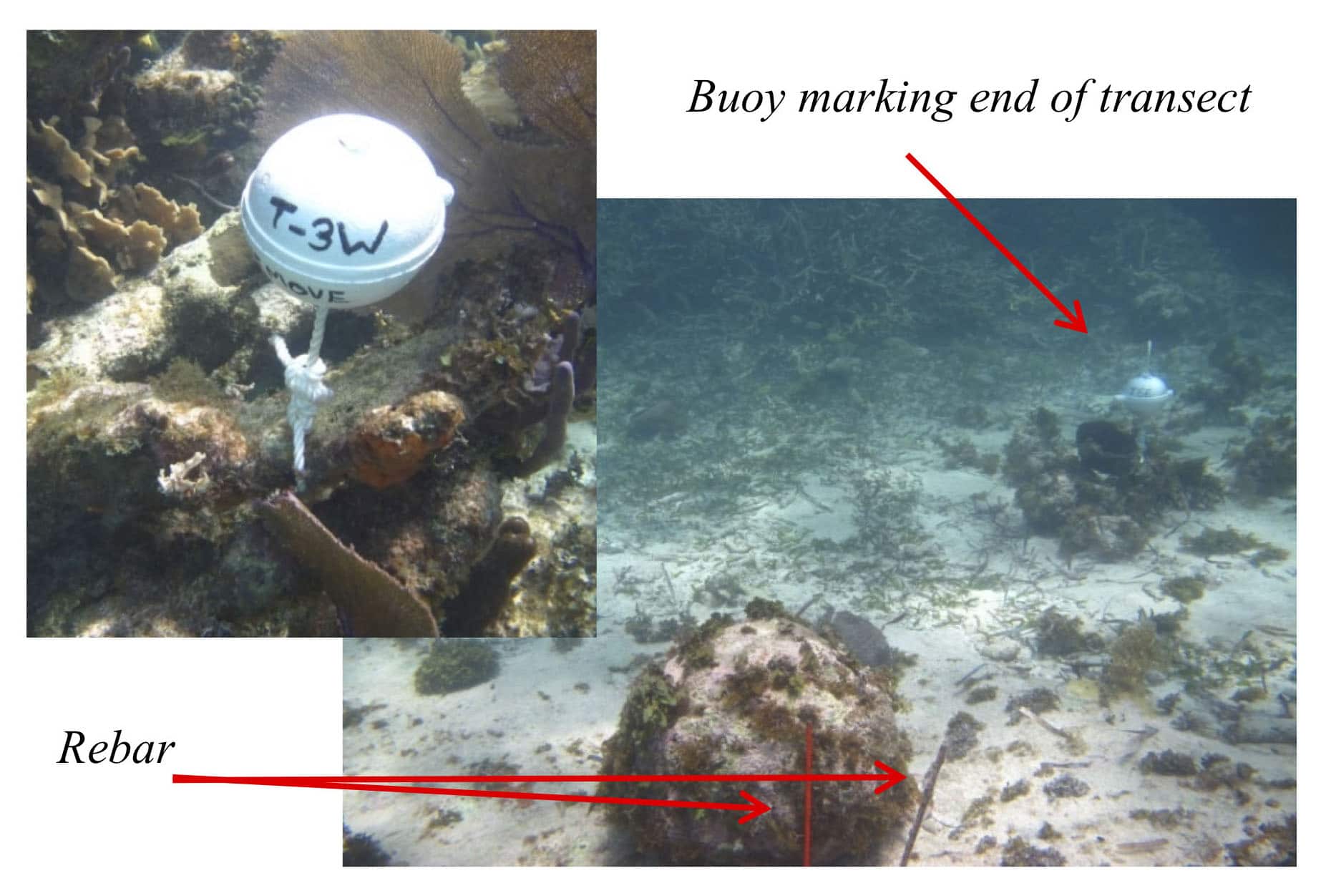
Figure 2: Each reef transect location is marked by rebar stakes, buoys, and GPS coordinates at both ends.

Background
Acroporid reefs in decline: Acroporid coral species are currently experiencing massive die-offs throughout the Atlantic basin and A. cervicornis and A. palmata are listed as threatened on the U.S. Department of the Interior Endangered and Threatened Wildlife list. Many scientists fear that A cervicornis may be particularly sensitive to environmental change and the demise of the species may be a sign of impending doom for Caribbean reefs in general (e.g. Precht and Aronson, 2004). A primary cause for collapse is White Band Disease (WBD; Rogers, 1985; Aronson and Precht, 2001), but many anthropogenic factors may be enhancing or driving disease effectiveness. Of the human-influenced threats to corals, macroalgae abundance due to overfishing and eutrophication, climate change, and potentially ocean acidification seem most important. In the last few decades reefs have experienced dramatic shifts from coral- to algae-dominated ecosystems (Hughes, 1994; Pandolfi et al., 2005), and it is now abundantly suggested that climate change may induce a massive collapse in coral reefs worldwide (e.g. Hughes et al., 2017; 2018).
Most living A. cervicornis today exist in small patches and isolated colonies, and true A. cervicornis-dominated ‘reefs’ are now rare (Miller et al., 2009). The question of whether the recent die-off of acroporids is anomalous with respect to the geologic record has been a subject of debate. Several key studies on the persistence of A. cervicornis prior to the 1980’s have been from Belize (Aronson et al., 1998; Aronson et al., 2002; Wapnick et al., 2004). Aronson et al. (2002) extracted 38 short cores from modern south-central Belize reefs to determine whether species turnover events were evident in Holocene acroporid-dominated reefs. They found no evidence for at least 3000 years in the Holocene of the phase shifts from acroporids to Agaricia tenulfolia (lettuce coral) that have characterized modern Belize reefs over the last few decades.
Potential Student Projects
We envision a wealth of possible student research projects at this location. Importantly, not all projects require SCUBA, so students who do not complete the SCUBA training will still have options. Potential student projects include the following:
Project 1: Nature vs. Nurture controls on three-dimensional A. cervicornis coral growth. A primary goal of this project will be to photograph and create 3D photogrammetry models for up to 36 existing coral samples that we placed on the reef and imaged during summer 2023 (Figs. 4 and 5). We mounted six small coral samples from 2 genets (from Coral Gardens and Loggerhead Caye in Southern Belize) each at Bacalar Chico Marine Reserve, Mexico Rocks, the Hol Chan Marine Reserve, Coral Gardens, and Caye Caulker Marine Reserve as well as at two sites in southern Belize (Whipray Caye and Silk Caye). We then created scaled models of each using a variety of software programs to precisely measure specimen dimensions. Our goal during Summer 2024 will be to re-survey all living samples that survived the 2023 marine heatwave to explore coral growth in time and space. 3-5 students.
Project 2: Is live A. cervicornis increasing or decreasing at Coral Gardens and is this reef in a phase transition from coral to algae dominance like most other reefs in the Caribbean? All students will participate in this project to some degree, as they will all contribute in some way to the photographic data analysis. A few students could easily make this the focus of their research experience, and several complimentary, but individual projects could evolve. We will conduct a comparative quantitative analysis of live coral tissue, macroalgae, and bare rock abundance from 2014-2019 to determine whether the coral or algae are increasing or in decline within and between sites at Coral Gardens, but also to what degree coral abundance is heterogeneous across the transect sites (which is clearly the case). 2-3 students.
Project 3: Do environmental measurements show a marked increase in temperature, conductivity, and/or light at this site from 2012-2024, and to what degree are these changes synchronous off the coast of Ambergris Caye? We have been collecting temperature data at 15 minute intervals across Coral Gardens, on land, and at additional sites (Manatee Channel to the south, and Rocky Point to the north) since 2012. We have been measuring pH and Dissolved Oxygen at six-month intervals for several years as well, and have limited variable conductivity and light data from several sites. These sites span the length of Ambergris Caye, variable shallow depths, and variable exposure to open-marine water. A key question we originally asked of this project (in 2011) was what is contributing to the survival of the Coral Gardens refugia? To date we still do not understand the degree to which normal temperatures at this site may contribute to the success of the refugium (via exposure to flushing of ‘new’ and possibly cooler water from outside the reef), or whether temperatures are now exceeding the recent norm at this site. 2-3 students.
Project 4: Have the changes in live coral cover impacted herbivory at Coral Gardens since the 2019 Keck Gateway project? And what implications might changes in herbivory and coral growth be for and the overall carbonate budget for Coral Gardens and how heterogeneous is it across time and space? We can determine roughly how much carbonate accretion is taking place at Coral Gardens reef by estimating live coral abundance, and using published data on coral growth rates and skeletal density of coral samples for each transect site and the whole Coral Gardens reef. We can also roughly estimate how fast carbonate is being excavated from reef framework by quantifying net annual bioerosion by grazers (fish and urchins) (Griffin et al., 2003 Mumby et al., 2006; Brown-Saracino et al., 2007); and macroborers from the literature (Hubbard et al., 1990; Perry et al., 2013). A comparison of herbivory data from 2024 with those from 2014-15 and 2019 will help place our estimates in the context of previous estimates of reef accretion from the literature. A key question centers on the degree to which the decline in live coral that we are observing matters to the geologic system as a whole. This project can easily involve several students with collaborative focus on fish, urchin, and damselfish surveys, net carbonate calculation, and the living coral dataset. 3-4 students.
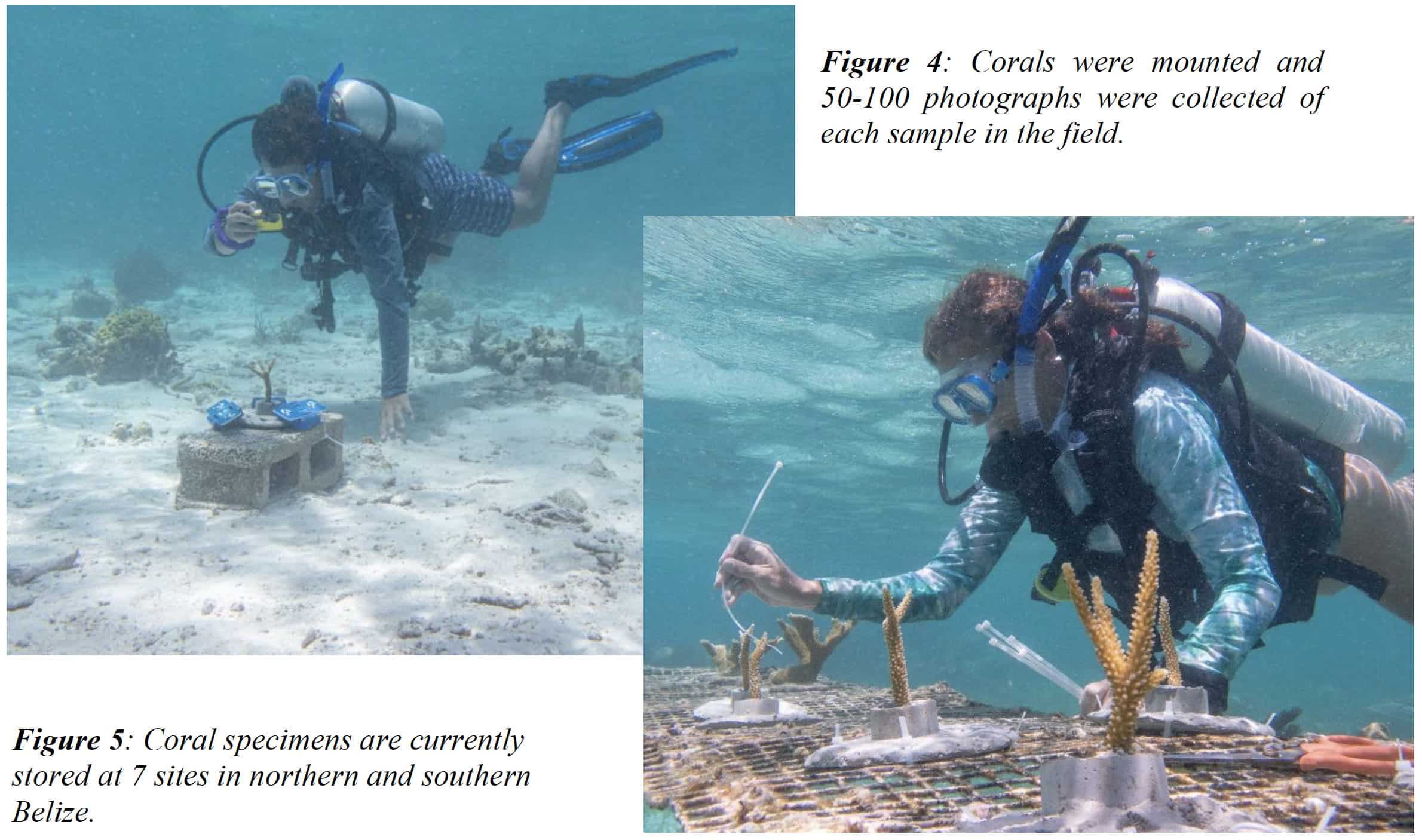
PROJECT LOGISTICS
Students will complete an online SCUBA knowledge course prior to the start of the field project. This course develops the knowledge base needed for the in-water SCUBA training and certification.
Project Preparation: In preparation for this project, the directors will communicate with all accepted students prior to the project period. Communication, exchange of documents, and team-building during the pre-field portion of the project will be facilitated with the use of a course-management system and video conferencing.
Washington and Lee University: We will spend approximately 1 week in Lexington prior to departure for Belize. The focus of this week is to build a sense of community, explore important concepts in reef science, and develop the knowledge and skills needed for field research. Group activities and discussions will provide opportunities for project participants to get to know each other, and to set norms and expectations (i.e., conversations about diversity, harassment, ethical conduct). Directors will start the project with a short course on coral reef geology, biology, and ecological dynamics assuming that most students have not been exposed extensively to this subject area. Students will learn about the methods we will use, explore prior data from Coral Gardens, and learn to identify the major corals and reef organisms using samples, and images from the AGGRA database (Marks, 2018). We will also begin to work on how to deconstruct a scientific paper and several key papers will be shared with everyone in the group. Students will be asked to complete a short writing assignment designed to help develop expertise about the study area and research problems under consideration. While we do not expect all projects to be determined before arrival in Belize, we will attempt to ensure that students are adequately prepared prior to the field season. We will work closely with each student to develop a research question, project design, a plan of action, and logistics during this period..
Belize: We will spend approximately 2 weeks in Belize collecting data from the field sites. In addition to conducting all aspects of the field work, students will also complete the open-water dives for SCUBA certification, and participate in field lectures by Dr. Ken Mattes (TREC Belize) and snorkeling experiences in a variety of reef habitats. We will meet with Emile Gomez and Brittany Garbutt from the Hol Chan Marine Reserve, Kira Foreman Castillo from MarAlliance, Lisa Carne and Victor Faux from Fragments of Hope and additional Belize colleagues to better understand the history of marine protected areas in Belize. We will continue to read and analyze papers and have meaningful discussions about ethical practices in science. We hope to also take one day to visit Mayan ruins and talk about the impacts of climate change on the Mayans.
Washington and Lee University: We will spend the last two weeks of the project period at Washington and Lee. Here students will learn computational techniques and they will quantify/analyze data. They will process photographic data using a number of software programs including MATLAB and analyze large environmental datasets using Excel. In addition, we will plan a few social events, hopefully some in collaboration with W&L ARC/AIM students (Advanced Research Cohort/Advanced Immersion Mentoring and other summer research students). This could include hikes, meals, or shared lectures or programming. In the last week we will work with students to craft posters and abstracts, hopefully for presentation at the annual GSA meeting in Anaheim, CA.
Working conditions and safety in the field
Working in the water can be physically demanding, whether using SCUBA or a snorkel. All students are required to be proficient swimmers. Students will be spending long hours on boats and in the water. Moderate wave action, mild tidal currents, rain, or windy conditions will not prevent data collection. We are working close to the tropics, and participants should be prepared to avoid sunburn and dehydration. In Belize we will be staying at the TREC Marine Field station (http://www.belizemarinetrec.com/) in comfortable but basic group accommodations. All but one or two days will likely be spent on and in the water. Most evenings will be spent processing data, discussing scientific papers, or preparing for the next field day. All students will be expected to work collaboratively and aid other field projects as needed.
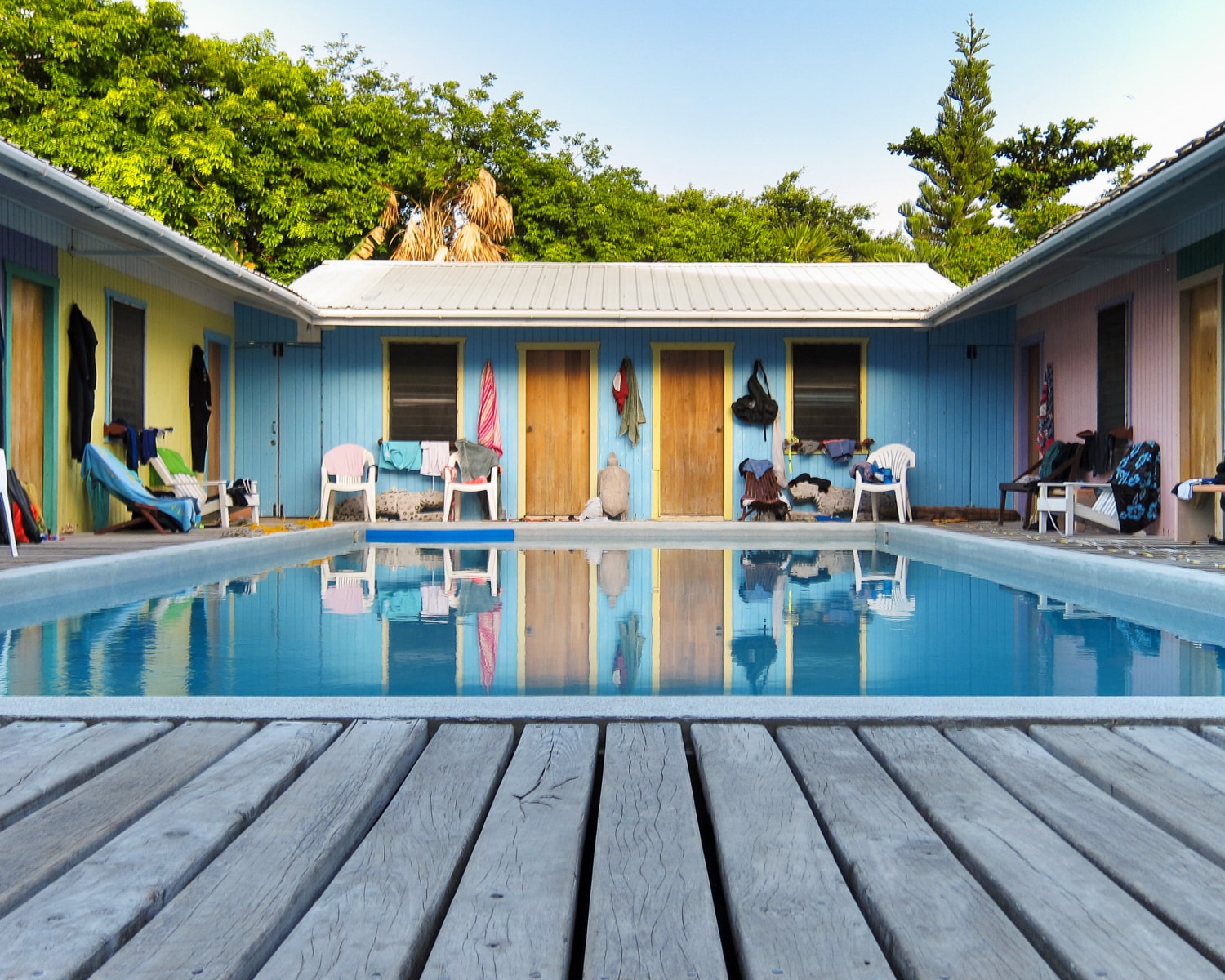
Cabins for researchers at TREC Marine Field Station.
We will require that all divers have a dive buddy at all times and Dr. Karl Wirth is a certified SCUBA instructor and a trained emergency first responder. Basic medical supplies will be available on the boat and at the field station. The nearest hospital, Karl Heusner Memorial Hospital, is in Belize City, a 20-minute flight and 15 minute drive from Ambergris Caye. Belize Medical Associates (emergency clinic) is about two minutes by taxi from Municipal Airport in Belize City. There are several small clinics on the island for non-emergency care. The only hyperbaric chamber in Belize is located on Ambergris Caye (http://ambergriscaye.com/pages/town/hyperbar.html), and all students will be required to purchase DAN (Divers Alert Network) insurance ($40 for individual insurance) which provides up to $150,000 for medical evacuation.
References
Anthony et al., 2015, Operationalizing resilience for adaptive coral reef management under global environmental change, Global Change Biology, 21: 48-61, doi: 10.1111/gcb.12700.
Aronson, R.B., Macintyre, I.G., Precht, W.F., Murdoch, T.J.T., and Wapnick, C. M., 2002, The expanding scale of species turnover events on coral reefs in Belize. Ecological Monographs 72:233–249.
Aronson, R.B. and Precht, W.F., 2001, White-band disease and the changing face of Caribbean coral reefs. Hydrobiologia, 460:25-38.
Aronson, R.B., Precht, W.F., and Macintyre, I.G., 1998, Extrinsic control of species replacement on a Holocene reef in Belize: the role of coral disease. Coral Reefs, 17:223- 230.
Brown-Saracino, J., Peckol, P., Curran, H.A., Robbart, M.L., 2007, Spatial variation in sea urchins, fish predators, and bioerosion rates on coral reefs of Belize. Coral Reefs 26 (1):71-78.
Busch, J., Greer, L., Harbor, D., Wirth, K., Lescinsky, H., and Curran, H.A., 2016, Quantifying exceptionally large populations of Acropora spp. corals in Belize using sub-meter satellite imagery classification. Bulletin of Marine Science, v.92, pp. 265-283. http://dx.doi.org/10.5343/bms.2015.1038
Cinner et al., 2016, Bright spots among the world’s coral reefs, Nature, 535: 416–419.
Cramer KL, Jackson JBC, Donovan MK, Greenstein BJ, Korpanty CA, Cook GM et al. Widespread loss of Caribbean acroporid corals was underway before coral bleaching and disease outbreaks. Science Advances. 2020; 6(17). https://doi.org/10.1126/sciadv.aax9395 PMID: 32426458
CurtisJ.H., Hodell, D.A., and Brenner, M., 1996, Climate variability on the Yucatan Peninsula (Mexico) during the past 3500 years, and implications for Maya cultural revolution. Quaternary Research, 46(1): 37-47.
Devlin-Durante, M.K., Miller, M.M., Caribbean Acropora Research Group (Carne, L., Smith, T., Banaszak, A.T., Greer, L., Irwin, A., Fogarty, N. Williams, D.), Precht, W.F., Baums, I.B., 2016, How old are you? Age estimates in a clonal animal. Molecular Ecology, v. 25, pp. 5628-5646. doi: 10.1111/mec.13865.
Donner, S.D., Rickbeil, G.J.M., and Heron, S.F., 2017, A new, high-resolution global mass coral bleaching database. PLOS ONE, 12,e0175490. Doi:10.1371/journal.pone.0175490pmid:28445534.
Druffel EM (1981) Radiocarbon in annual coral rings from the eastern tropical pacific ocean. Geophysical Research Letters, 8(1), 59-62. doi: 10.1029/GL008i001p00059.
Gardner, T.A., Cote, I.M., Gill, J.A., Grant, A., and Watkinson, A.R., 2003, Long-Term Region Wide Declines in Caribbean Corals. Science, 201:958-960.
Greenstein, B.J., Curran, H.A., and Pandolfi, J.M., 1998, Shifting ecological baselines and the demise of Acropora cervicornis in the Western North Atlantic and Caribbean Province: A Pleistocene perspective. Coral Reefs 17:249–261.
Greer, L., Jackson, J., Curran, H.A., Guilderson, T., and Teneva, L., 2009, How vulnerable is Acropora cervicornis to environmental change? Lessons from the early to mid-Holocene. Geology, 37:263-266.
Greer, L, Waggoner, T, Guilderson, T, Clark, T, Curran, HA, Busch, J, Lescinsky, H, Wirth, K, Harbor, D, 2016, Coral Gardens Belize: An Acropora spp. refugia identified. 13th International Coral Reef Symposium, Honolulu, Hawaii.
Greer L, Clark T, Waggoner T, Busch J, Guilderson TP, Wirth K et al. Coral Gardens Reef, Belize: A refugium in the face of Caribbean-wide Acropora spp. decline. PLoS ONE. 2020; 15(9):e0239267. https://doi.org/10.1371/journal.pone.0239267 PMID: 32997690.
Greer, L., Curran, H.A., Wirth, K., Humston, R., Johnson, G., McManus, L., Stefanic, C., Lescinsky, H., Clark, T., and Forman-Castillo, K., 2023, Coral Gardens Reef, Belize: An Acropora spp. refugium under threat in a warming world. PLoS ONE 18(2): e0280852. doi.org/10.1371/journal.pone.0280852
Griffin, S.P., Garcia, R.P., and Weil, E., 2003, Bioerosion in coral reef communities in southwest Puerto Rico by the sea urchin Echinometra viridis. Marine Biology, 143: 79084.
Hubbard, D.K., Gladfelter, E.H., and Bythell, J.C., 1994, Comparison of biological and geological perspectives of coral-reef community structure at Buck Island, U.S. Virgin Islands, in R. N. Ginsburg, editor, Proceedings of the colloquium on global aspects of coral reefs: health, hazards and history. Rosenstiel School of Marine and Atmospheric Science, University of Miami, Miami, Florida, USA, 201-207
Hubbard, D.K., Miller, A.I., and Scaturo, D., 1990, Production and cycling of calcium carbonate in a shelf-edge reef system (St. Croix, U.S. Virgin Islands); applications to the nature of reef systems in the fossil record. Journal of Sedimentology, 60:335-360.
Hughes, T.P., 1994, Catastrophes, phase shifts, and large-scale degradation of a Caribbean coral reef. Science, 265(5178):1547-1551.
Hughes et al., 2003, Climate change, human impacts, and the resilience of coral reefs. Science, 301, 929–933 (2003). doi:10.1126/science.1085046pmid:12920289.
Hughes et al., 2017, Global warming and recurrent mass bleaching of corals. Nature, 543, 373–377, doi:10.1038/nature21707pmid:28300113.
Hughes et al., 2018, Spatial and temporal patterns of mass bleaching of corals in the Anthropocene, Science, 359:80-83. DOI: 10.1126/science.aan8048.
Irwin, A., Greer, L., Humston, R., Devlin-Durante, M., Cabe, P., Lescinsky, H., Wirth, K., Curran, H.A., and Baums, I., 2017, Age and intraspecific diversity of resilient Acropora communities in Belize. Coral Reefs, 36(4), 1111-1120, doi:10.1007/s00338-017-1602-9.
Jackson, J.B.C., 1992, Pleistocene perspectives on coral reef community structure. American Zoologist, 32:719-731.
Jackson, J.B.C., 2001, What was natural in the coastal oceans. Proc. of the Nat. Acad. of Sciences, 98(10):5411-5418.
Kavousi J, Keppel G. Clarifying the concept of climate change refugia for coral reefs. ICES Journal of Marine Science. 2018; 75(1):43–49.
Keppel G, Van Niel KP, Wardell-Johnson GW, Yates CJ, Byrne M, Mucina L et al. Refugia: identifying and understanding safe havens for biodiversity under climate change. Global Ecology and Biogeography. 2012; 21(4):393–404.
Marks, K.W., 2018, AGRRA Database, version (2018-03). Available online <http:www.agrra.org/data-explorer-summary-products/>
Mazzullo, S.J., Anderson-Underwood, K.E., Burke, C.D., and Bischoff, W.D., 1992, “Holocene coral patch reef ecology and sedimentary architecture, northern Belize, Central America.” Palaios, 7(6):591-601.
Medley, P., Tibert, N.T., Patterson, W.P., Curran, H.A., Greer, L., and Colin, J.P., 2007, Paleohydrology of middle Holocene lagoonal and lacustrine deposits in the Enriquillo Valley, Dominican Republic: Pore morphometrics and isotope geochemistry of ostracoda. Micropaleontology, v. 53, no. 5, pp. 409-419.
Miller, S.L., Chiappone, M., Rutten, L.M., and Swanson, D.W., 2009, Population status of Acropora corals in the Florida Keys. Proc. of the 11th Int. Coral Reef Symp., Ft. Lauderdale, FL, 775-779.
Mumby, P.J., Dahlgren, C.P., Harborne, A.R., Kappel, C.V., Micheli, F., Brumbaugh, D.R., Holmes, K.E., Mendes, J.M., Broad, K., Sanchirico, J.N., Buch, K., Box, S., Stoffle, R.W., and Gill, A.B., 2006, Fishing, trophic cascades, and the process of grazing on coral reefs. Science, 311 (5757):98-101. DOI: 10.1126/science.1121129
Knowlton, N., 2017, Doom and gloom won’t save the world, Nature 544(7650): 271.
Kuffner, I.B. and Toth, L.T., 2016, A geological perspective on the degradation and conservation of western Atlantic coral reefs Conservation Biology, 30(4): 706-715.
Metcalfe, S. et al., 2009, Environmental change in northern Belize since the latest Pleistocene, Journal of Quaternary Science, 24(6): 627-641.
Normile, D., 2016, El Niño’s warmth devastating reefs worldwide, Science, 352:15-16, DOI: 10.1126/science.352.6281.15
Pandolfi, J.M., Jackson, J.B.C., Baron, N., Bradbury, R.H., Guzman, H.M., Hughes, T.P., Kappel, C.V., Micheli, F., Ogden, J.C., Possingham, H.P., and Sala, E., 2005, Are U.S. coral reefs on the slippery slope to slime? Science, 307:1725–1726, DOI: 10.1126/science.1104258.
Perry, C.T, Murphy, G.N., Kench, P.S., Smithers, S.G., Edinger, E.N., Steneck, R.S., and Mumby, P.J., 2013, Caribbean-wide decline in carbonate production threatens coral reef growth. Nature Communications, 4:1402, DOI: 10.1038/ncomms2409.
Precht, W.F. and Aronson, R.B., 2004, Climate flickers and range shifts of reef corals, Frontiers in Ecology and the Environment, 2:307-314.
Reimer PJ, Bard E, Bayliss A, Beck JW, Blackwell PG, Bronk-Ramsey C, Grootes PM, Guilderson TP, Haflidason H, Hajdas I, HattŽ C, Heaton TJ, Hoffmann DL, Hogg AG, Hughen KA, Kaiser KF, Kromer B, Manning SW, Niu M, Reimer RW, Richards DA, Scott EM, Southon JR, Staff RA, Turney CSM, van der Plicht J (2013) IntCal13 and Marine13 Radiocarbon Age Calibration Curves 0-50,000 Years cal BP. Radiocarbon, 55(4).
Rogers, C.S., 1985. Degradation of Caribbean and western Atlantic coral reefs and decline of associated fisheries, in Proceedings of the fifth international coral reef congress, Tahiti, C. Gabrie and M. Harmelin-Vivien, editors. Volume 6. Antenne Museum-EPHE, Moorea, French Polynesia, 491-496.
Schleussner, C.-F., Lissner, T. K., Fischer, E. M., Wohland, J., Perrette, M., Golly, A., Rogelj, J., Childers, K., Schewe, J., Frieler, K., Mengel, M., Hare, W., and Schaeffer, M., 2016, Differential climate impacts for policy-relevant limits to global warming: the case of 1.5 °C and 2 °C, Earth System Dynamics, 7, 327-351, https://doi.org/10.5194/esd-7-327-2016, 2016.
Spalding, M.D. and Brown, B.E., 2015, Warm-water coral reefs and climate change, Science, 350: 769-771, DOI: 10.1126/science.aad0349.
Waggoner, T., Greer, L, Guilderson, T, Clark, T, Busch, J., Biegel, J., Lustig, H., Curran, HA, Lescinsky, H, Wirth, K, 2015, Chronological persistence of Acropora cervicornis at Coral Gardens, Belize. GSA Abstracts with Programs Vol. 47, No. 7.
Waggoner, T. (’16, Honors), 2016, Chronological Persistence of Acropora cervicornis at Coral Gardens, Belize. Honors Thesis
Wapnick, C.M., Precht, W.F., and Aronson, R.B., 2004, Millennial-scale dynamics of staghorn coral in Discovery Bay, Jamaica. Ecology Letters, 7(4):354-361.
Winsor, K., Curran, H.A., Greer, L., and Glumac, B., 2012, Unusual Holocene Serpulid/Tufa Bioherms, Enriquillo Valley, Dominican Republic: Morphologies and Paleoenvironmental Implications, Palaios v. 27, 693-706, DOI: 10.2110/palo.2011.p11-118r.

